We independently review everything we recommend. When you buy through our links, we may earn a commission.
How to Easily Grill Vegetables Like a Pro

When it comes to grilling, burgers and hot dogs seem to get the lion’s share of the press. Fortunately for the health-conscious, the technique can also be applied to vegetables—and to great effect. The natural sugars in the veggies will caramelize when exposed to an open flame, giving you a tender-crisp texture and mouthwatering flavor.
Here’s a complete guide to help you achieve optimum results when cooking vegetables on the grill.
Things to Do Before Grilling Vegetables
Step 1: Clean the cooking grates thoroughly using hot, soapy water. If your grates are dirty, the ingredients may become stuck during cooking, which can destroy delicate vegetables like asparagus and tomatoes.

Step 2: Prepare the vegetables for the grill: If you need tips on how to give each ingredient the proper treatment, see the “Best Vegetables For Grilling“.
Note: If you’re using a charcoal or pellet grill, you should skip ahead to step 3, then prepare the veggies while the grill is heating.
Step 3: Set the heat: Set the heat to the desired temperature (see “Cooking Times and Temperatures“, below). If you’re preparing a variety of different veggies, a medium-high fire is preferable.
For gas grills, this is simple enough—just turn the burners to the medium-high setting, and you’re ready to go. Pellet grills should be set to 450 degrees and allowed to heat for 10-15 minutes before grilling vegetables. For charcoal grills (including kamado grills), light the fire as you normally would. When the coals are yellowish-brown in color and you can hold your hand over them for 2-3 seconds before pulling away, your fire should be medium-hot.
Step 4: Season the vegetables: Just before you add the veggies to the grill, add a thin coating of olive oil and season them liberally with salt. Don’t go overboard with the oil, as this can lead to flare-ups. The last thing you want is for the food to be swallowed up by black smoke before you’ve had a chance to achieve those prized grill marks.
Best Vegetables for Grilling
1. Grilling Corn
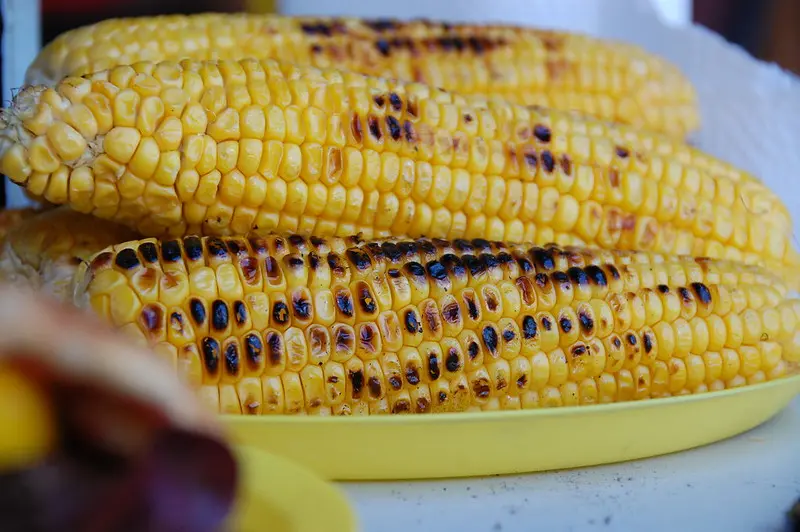
While technically a grain, corn is widely regarded as a vegetable. During the summer months, it’s a staple of backyard BBQs and other outdoor gatherings. Grilled corn has a sweet, smoky flavor that has little in common with the bloated, steamed version you may have been subjected to in the past.
To give the ears the royal treatment they deserve, make sure the stems are barely moist and the husks are green and healthy. We prefer placing the corn directly over medium heat, turning every few minutes. It’s fine for the husks to get a good char on them, but you should move the corn to a cooler part of the grill if the silks begin to burn.
When the ears have cooled slightly, remove the husks. Serve with butter and salt.
2. Grilling Eggplant
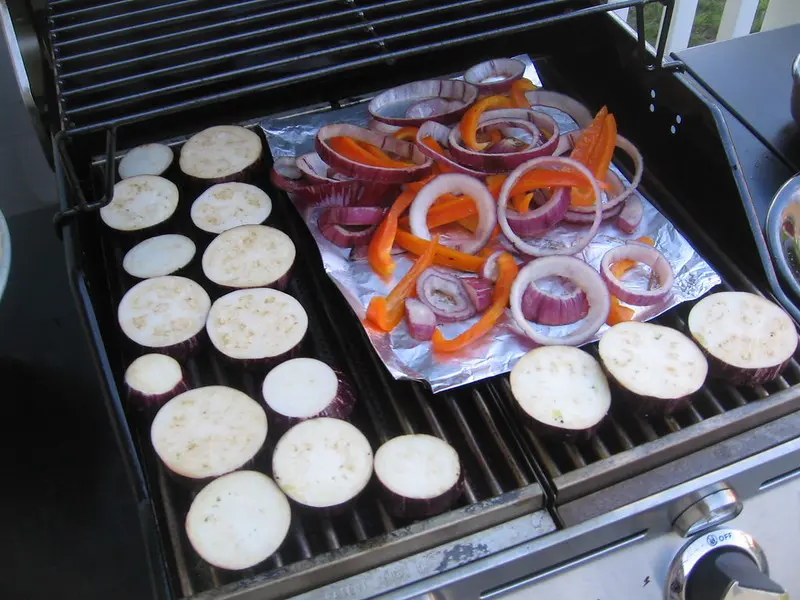
Since eggplant is typically used as a meat substitute in vegetarian cuisine, it’s a natural partner for the grilling treatment. The vegetable has a firm, meaty texture that stands up well to high-heat cooking applications.
Preparing eggplant for the grill is simple. First, cut off the stem and rounded bottom, then set the cylinder on one end. Trim the edges so that you have a rectangle that’s fairly uniform in width. While the eggplant is still in this position, cut it lengthwise into thick planks.
Tip: Eggplant is a versatile ingredient that pairs well with many flavors. Once you’ve removed it from the grill, try brushing the planks with a bit of basil pesto or Italian dressing.
3. Grilling Zucchini
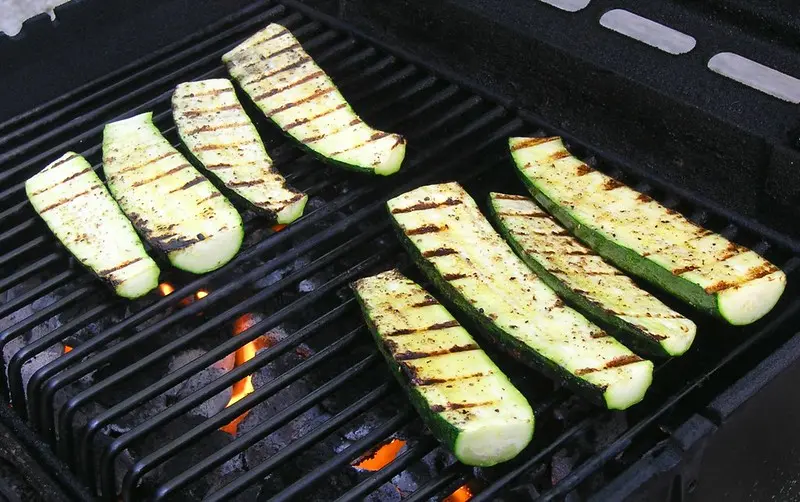
This vibrant green summer squash is a snap to prepare and takes just minutes to cook over a hot fire.
With a sharp knife, remove the stem and the rounded end from each zucchini. Trim the edges and cut crosswise in half, then divide the halves into planks (you should have 4-6 planks per zucchini, depending on size).
After cooking, zucchini should be eaten as soon as possible, or it becomes limp and mushy. Try brightening the flavors by topping the grilled planks with an olive tapenade.
4. Grilling Onions
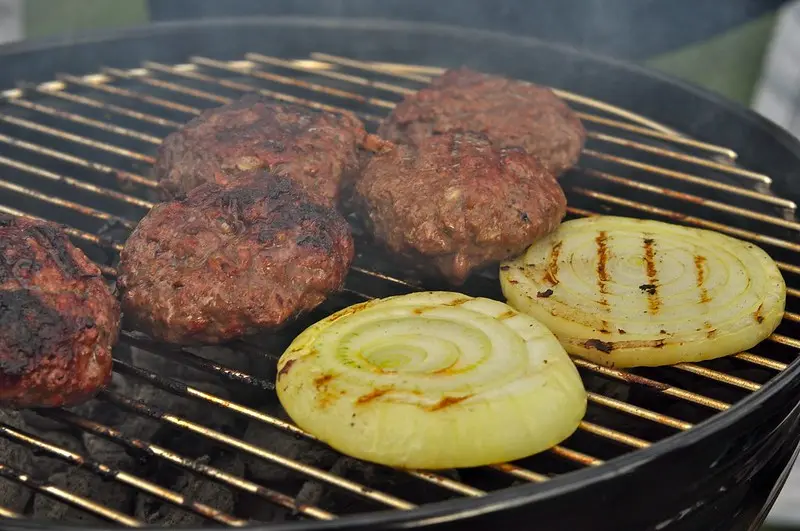
Whenever we hear someone claim that they dislike onions, our first response is to ask if they’ve ever tried grilling them. When cooked properly, onions are sweet and not at all bitter, and flame-broiling lends them enticing savory notes.
To begin, remove the skin and any green outer layers. Trim off the stem. For best results, cut the onions lengthwise into quarters—that is, from the stem end to the root end. Larger onions may need to be cut into six pieces instead of four. Just make sure they’re all a uniform size, so that they’ll cook evenly.
While it might seem like overkill to pair onion with another type of onion, minced chives are a great accompaniment. The grilled onions will also benefit from an extra drizzling of olive oil after they’ve been removed from the heat. If you have a variety of flavored oils on hand, try experimenting with some of those.
5. Grilling Broccoli
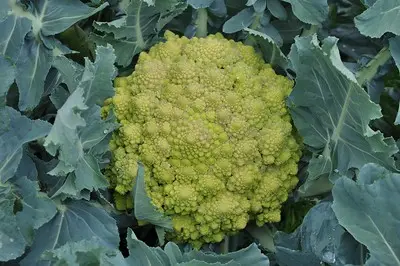
These nutritious stalks undergo a dramatic transformation when they’re exposed to high heat. The caramelized sugars give them an addictive nutty, crunchy quality.
Remove the broccoli from its core, keeping the stalks as long as possible, as this will make them easier to turn. The florets should measure about one inch across, with at least one flat edge to maximize their exposure to the heat.
Broccoli pairs well with many different flavors. Try adding a dash of tamari to the grilled florets, or sprinkle them with toasted pine nuts.
6. Grilling Bell Peppers
Like onions, bell peppers hold up well when cooked over high heat. In addition to achieving a nice sear, their flesh takes on an appealingly soft texture. They also add a wonderful burst of color to the plate. We prefer the sweet flavor of red, green, and orange peppers for the grill, but you can substitute green ones in a pinch.
Choose peppers that are heavy for their size, with no scratches or soft spots. To remove the core, press down on a spot near the stem until the flesh breaks. Scoop out the core along with the stem, and scrape out any remaining seeds, as well as the inner ribs. Divide peppers into quarters. Again, try to select peppers that are about the same size to ensure even cooking.
Peppers don’t require much accompaniment, but feel free to brighten them up with a handful of freshly minced parsley before serving.
7. Grilling Asparagus
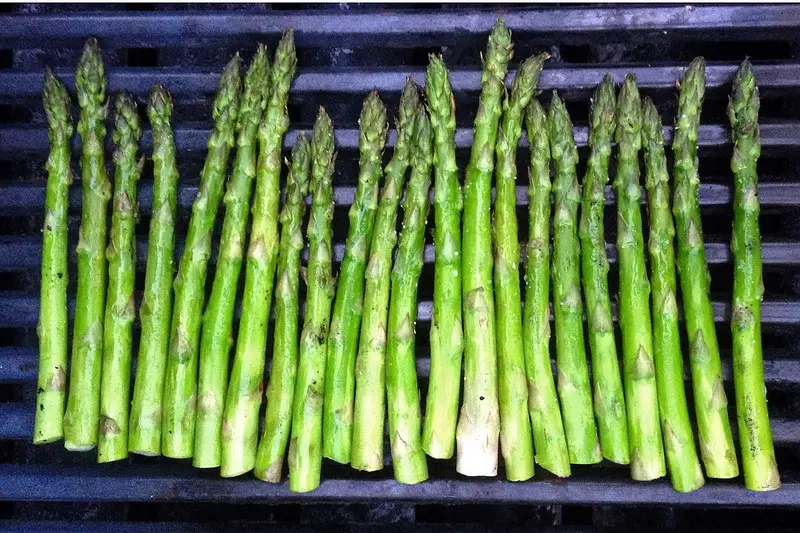
While you might be tempted to seek out extra-thick asparagus for the grill, it’s possible to grill thinner stalks as well. If you go this route, it’s a good idea to invest in a grill basket to keep the stalks from slipping through the cooking grate.
Asparagus stalks have tough, fibrous ends that are usually white in color. Instead of trimming them off with a knife, you can remove them by bending the stalks about two-thirds of the way toward the end. They should naturally break in the right spot when gentle pressure is applied.
Finish grilled asparagus with a squeeze of fresh lemon juice—or, for a special treat, whip up a batch of hollandaise and keep it warm while the vegetables are cooking.
8. Grilling Portobello Mushrooms
The firm, meaty texture of these mushrooms makes them a fine choice for the grill.
To prepare a Portobello, snap off the stem and use a spoon to remove the darkly colored gills on the underside. Wash them thoroughly to remove any residue. Since Portobellos hold up well to marinades, you can toss them with a mixture of balsamic vinegar, olive oil, soy sauce, and herbs, and let them sit for about half an hour before cooking.
9. Grilling Carrots
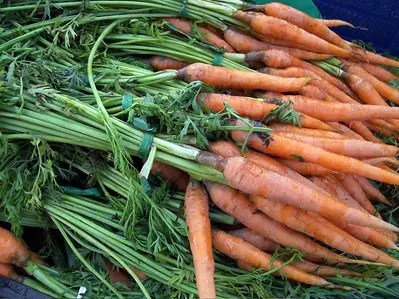
For best results, use medium-sized carrots—the fresher the better. During the summer months, try to find locally grown carrots at a farm stand or farmer’s market.
Trim the green ends so that you’re left with just a tiny part of the stem for easy gripping. Peel the carrots before tossing them with olive oil. You can also experiment with spices such as cumin, coriander, and Chinese five-spice powder. For best results, cook carrots over medium-high heat for the first 10 minutes, then switch to indirect heat for the last 15-20 minutes.
Best Cooking Times and Temperatures for Vegetable Grilling
| Vegetable | Temperature | Total Cooking Time |
|---|---|---|
| Corn | medium | 30 minutes, turning frequently |
| Eggplant | medium – high | 10 minutes, turning once |
| Zucchini | medium | 8 minutes, turning once |
| Onions | medium | 20 minutes, turning once |
| Bell peppers | medium – high | 10 minutes, turning once |
| Broccoli | medium – high | 10-12 minutes, turning frequently |
| Asparagus | medium – high | 4-6 minutes, turning once |
| Carrots | medium – high | 25-30 minutes, turning frequently and moving to indirect heat for last 15-20 |
| Portobello Mushrooms | medium | 8-10 minutes, turning once |
How to Grill Vegetables in Foil – A Small Guide
When you use a foil packet to cook veggies on the grill, you’re actually steaming them, rather than grilling. That’s because the foil traps the moisture inside, giving your ingredients a moist, tender texture.
Since this method is largely hands-off, we like to use it for hearty vegetables like onions, carrots, and mushrooms. Their texture allows for a greater margin of error if you leave them on a bit too long. It also works well for veggies that naturally contain a lot of moisture, like tomatoes and zucchini. However, it can be used for any number of ingredients if you’re willing to pay close attention.
How to cook vegetables in a foil packet on a grill – Step-by-step:
- Chop or slice your vegetables into bite-sized pieces, and season as desired. While olive oil, salt, and freshly ground black pepper are staples, feel free to add fresh herbs, flavored oils, or vinegar (depending on which veggies you’re using).
- Pull out a sheet of aluminum foil about 18 inches long.
- Fold the sheet in half lengthwise, so it measures about 9 inches.
- Place your prepared vegetables in the center of the sheet.
- Fold one half of the foil over the vegetables, as if you’re closing a book. Fold and pinch the edges to create a seal.
- Fold the other two edges to form a closed packet. Don’t fold it too tight—you want the moisture to have sufficient room to expand.
- Place the packet over indirect medium heat for 25-30 minutes, or until the vegetables are tender. Bear in mind that delicate ingredients such as asparagus will be done more quickly. In these cases, you can carefully open the packet after 5-10 minutes to check on their progress.
- Take care when opening the foil packet, as the contents will be extremely hot.
What’s the Best Way to Serve Grilled Vegetables?
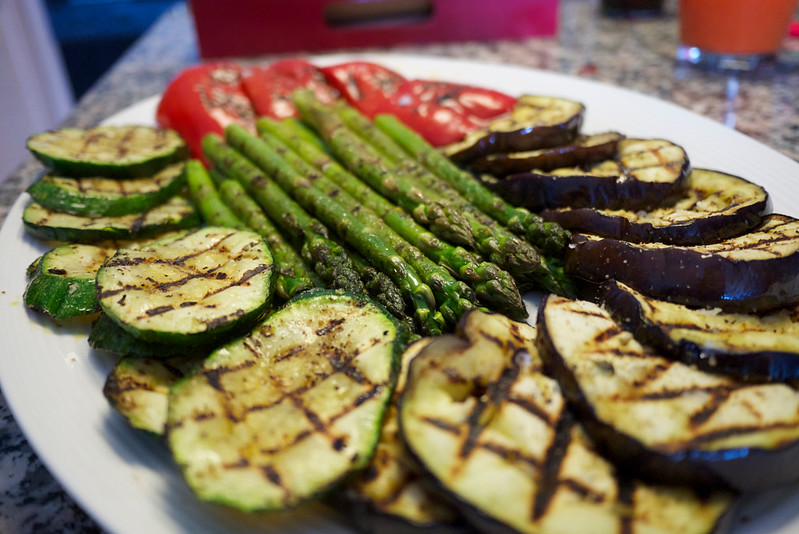
When it comes to serving grilled veggies, you have a range of options. Here’s a guide to some of the most popular ones.
- Drizzle with your favorite salad dressing or herb-infused olive oil.
- Top with finely grated Parmesan or cheddar cheese. For eggplant, zucchini, and other summer squash, try substituting crumbled feta for a Mediterranean kick.
- Top with homemade salsa or pico de gallo. If you’ve never sampled tomatillo salsa (the green kind), try adding a dollop to grilled sweet onions.
- Top eggplant or mushrooms with romesco sauce, and serve alongside pasta for a satisfying main course.
- Tuck leftover grilled vegetables into pita bread for a quick, nutritious lunch.
- Use grilled veggies to round out a salad or grain bowl.
Once you’ve incorporated fresh vegetables into your grilling lineup, you’ll open up the door to a whole new world of flavor combinations. By following the advice we’ve given, you should be able to satisfy even the most dedicated carnivore on your guest list.
Feel free to leave your own tips below in the comment section. Best of luck, and happy grilling!
